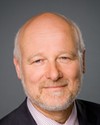I finally strapped it on next to the iliac crest. The kidneys might be exposed, but hopefully there's a little more shielding there. I can tell you that I felt a pain in my hip when I started to carry that thing 15 years ago, after I was elected, because I had never carried one before. Eventually that pain was shut down. I think that would be habituation.
After 10 years, that pain started to come back, so I've switched to the opposite side. I noticed that when I talked on a cellphone for more than a few minutes, I would get a pain in the temple. That causes me some concern.
That's just anecdotal, of course, but I think the information you're presenting here is a bit alarming, since you mentioned that the literature search ended in 2011—


